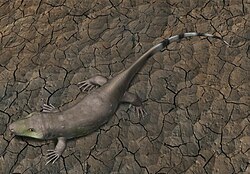Tseajaia campi
|
Tseajaia Temporal range: Permian |
|
|---|---|
 |
|
| Tseajaia life reconstruction | |
| Scientific classification | |
| Kingdom: | Animalia |
| Phylum: | Chordata |
| Order: | †Diadectomorpha |
| Family: | †Tseajaiidae |
| Genus: |
†Tseajaia Vaughn, 1964 |
Tseajaia is an extinct genus of tetrapod. It was an anthracosaurian that lived in the Permian of North America. The skeleton is that of a medium-sized, rather advanced reptile-like amphibian. In life it was about 1 metre (3 ft) long and may have looked vaguely like an iguana, though slower and with a more amphibian foot without claws. The dentition was somewhat blunt, indicating herbivory or possibly omnivory.
Tseajaia was described from a single, fairly complete specimen and was given its own family by Robert L. Carroll. It was originally thought to be a Seymouriamorph. Additional finds allowing for a better taxonomic analysis indicate they belong in the Diadectomorpha, as the sister group to the large and more derived Diadectidae. Tseajaia itself being a fairly generalized form, gives a reasonable indication of the build and looks of the closest relatives of the amniotes.
...
Wikipedia
